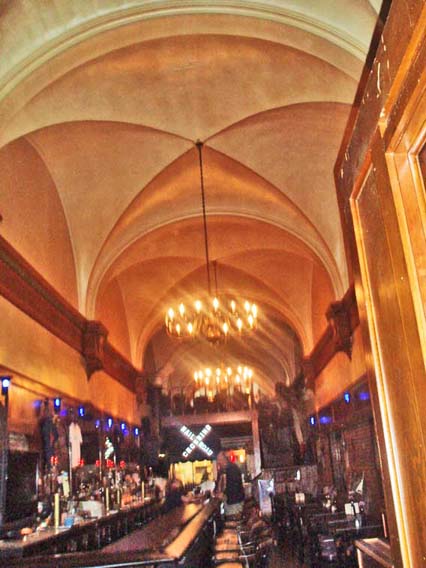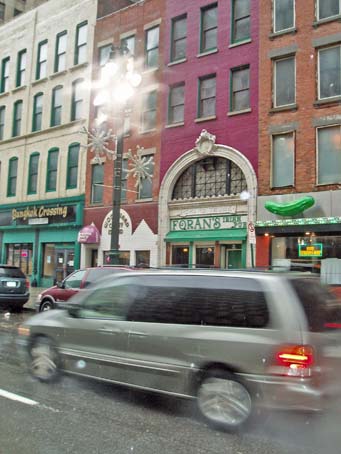Traub Brothers Jewelry Building/
Traub Brothers Jewelry Building/
Grand Trunk Railroad City Ticket Office/Foran’s Irish Pub
612 Woodward near Campus Martius in downtown Detroit
The north side of Woodward between Larned and Campus Martius became a retail shopping center in the 1870s as Detroit became a prosperous industrial metropolis. As the urban middle class grew in size and as their incomes ascended, merchants could specialize in particular goods. The east and west ends of this interesting block are occupied by impressive buildings Albert Kahn designed—the 1917 Vinton Building—his first skyscraper at 600 Woodward—and his 1922 First National Bank Building. In between those two structures, you find the Martin Limbach Hardware Building at 608, the Traub Brother building at 612, the W. G. Vinton Company Building at 616 and an array of five similar buildings constructed for Mabley and Company, a department store. All of these structures are wood framed structures four stories in height with brick facing on their fronts. The architects paid attention to designing stylish windows at the upper levels. Presumably, the ground level was used for retail trade while the elevated stories provided a residence for the proprietor or for renters. Some of the upper level space may have been used for warehousing stock.
The Grand Truck Railway, financed primarily by British capital, built an extensive system that by 1859, stretched from Portland, Maine up to Montréal, across Québec, then through Toronto and west to Sarnia, Ontario. The entrepreneurs assumed that ships from around the world would dock in Portland or Montréal. The Grand Trunk would deliver their products to Canada and the Midwest of the United States. Its trains would take agricultural and manufactured products from the Midwest and inland Canada for export from Portland or Montréal.
In 1860, the firm laid rails from Port Huron to Detroit. In the 1860s, Grand Trunk officials understood that profits could be made by linking their lines to Chicago which was quickly arising to become the key mercantile point in the Midwest. It took them a while to build and buy a line west from Port Huron. In the meantime, they built or purchased lines linking Windsor, Ontario to Buffalo and Toronto. They expanded their lines across Michigan and, by the 1880s, the Grand Trunk completed a major line from Port Huron to Chicago and another from Detroit to Grand Haven where freight was to be put on boats for shipment west. These lines intersected in Durand, Michigan, the site of one of the most famous depots in the country. The Grand Trunk offered through service from Detroit to Chicago on this rather circuitous line, a line that dipped into Indiana after leaving Battle Creek and Cassopolis, then visited South Bend and Valparaiso before reaching Chicago. Indeed, the passenger trains on this line survived until the start of Amtrak in May, 1971. The Grand Trunk’s primary station in Detroit was near the intersection of Brush and Atwater and remained there until it was demolished for construction of the Renaissance Center. The Grand Trunk had direct trains from Detroit to numerous points in Michigan and to Chicago. You could also board train cars in Detroit for destinations in Canada. Until the 1950s, these cars were pushed onto the railroad car ferries that once plied the Detroit River, were off-loaded in Windsor and then attached to trains departing for Toronto, Montréal and intermediate stations.
In the era of rail travel, stations were often located at some distance from the central business district. Railroads opened what are known as city ticket offices so that businessmen and travelers could readily purchase tickets without making a longer trip to the station. In the 1890s, the Grand Trunk Railroad had a ticket office at the southwest corner of Woodward and Jefferson where the Michigan Gas Company building designed by Minoru Yamasaki now stands. Apparently, the Grand Trunk closed that office and, in 1903, purchased the building at 612 Woodward that you see pictured above.

After the Grand Trunk secured this building, they ripped out the second floor and put in an elegant vaulted ceiling 25 feet in height with very attractive woodwork. Brass chandeliers cast their light on hardwood floors. Presumably, this suggested to customers that they were purchasing tickets in a building almost as elegant as the rail stations constructed in that era. You will note that the carved stone work on the Woodward façade proudly proclaims Grand Trunk with the company’s logo engraved in stone at a higher elevation. If you go inside today, you will see the GT logo then used to imprint the line’s name in their customers’ minds. This logo was carved in the woodwork in several places. Until the government established Amtrak in spring 1871, the Michigan Central Railroad and the Grand Trunk competed for Detroit to Chicago passengers. The Michigan Central got the lion’s share of the business because of its more direct route. In the 1930s, the Grand Trunk closed this downtown ticket office. I read that the Metropole Hotel opened a bar in this building as soon as prohibition ended. They may have obtained one of the first licenses to sell liquor in Detroit after the Twenty-first Amendment, on December 5, 1933, overturning the Eighteenth Amendment was approved. I believe that the first floor has been operated as a bar and restaurant for most of the last 75 years but with different owners and names. At some points, this place had the reputation of being a favorite spot for city and county political officials who needed sarsaparilla or some similar liquid.
The current owner of the establishment has a strong interest in the heritage of this building. A visit to the location reveals that a gradual restoration is very well underway, creating the ambiance and railroad themes that the Grand Truck officials conceived some 105 years ago. There are plans to convert the contiguous Vinton Building into condominiums. If that is accomplished and if additional buildings in downtown Detroit are renovated into condominiums, one can imagine thriving activity for the restaurant now located in this former city ticket office and those in the Mabley Company structure.
The Grand Trunk Railroad, facing bankruptcy at the end of World War I, was nationalized by the Canadian government at the start of 1920. It was then merged with the Canadian National, a crown corporation and the largest railroad in Canada with tracks reaching as far east as St. John's, Newfoundland and as far west as Prince Rupert, British Columbia. The lines in Michigan were operated independently as the Grand Trunk Western Railway. In 1992, the Canadian government began the slow process of privatizing the Canadian National Railroad. After the privatization was complete, the Grand Trunk name disappeared and the 447 miles of Grand Truck lines that remain in Michigan are now known and labeled as the Canadian National Railroad.
Architect: Unknown to me
Date of Construction of original building: 1879
Use in 2008: Foran’s Irish Pub
Website: http://foransirishpub.com/
City of Detroit Designated Historic District: Not listed
State of Michigan Registry of Historic Sites: Not listed
National Register of Historic Places: This building is included in the Detroit Financial Historic District, #09001067; Listed
December 24, 2009
Photograph: Ren Farley; November 15, 2008
Description updated: November, 2010
Return to Transportation
Return to Homepage


